Ivica Mitrovic and Kerstin Dautenhahn (2003)
Social Attitudes: Investigations with Agent Simulations Using Webots
Journal of Artificial Societies and Social Simulation
vol. 6, no. 4
To cite articles published in the Journal of Artificial Societies and Social Simulation, please reference the above information and include paragraph numbers if necessary
<https://www.jasss.org/6/4/4.html>
Received: 9-Jan-2003 Accepted: 8-Jul-2003 Published: 31-Oct-2003
 Abstract
Abstract

|
| Table 1. Socio-political attitudes, of three ideal types, toward issues that are selected from their stories (grand narratives), as presented in Petric et al. (2002) |

|
| Figure 1. Examples of three different agents: agent with indeterminate socio-political type (neo-liberal component is 0, alternative component is 0.5 and fundamentalist component is 0.5), neo-liberal agent (n=1, a=0, f=0) and alternative agent (n=0, a=1, f=0) |

|
| Figure 2. All possible agents' socio-political types that could occur in the simulation. Top: neo-liberal, alternative and fundamentalist agent. Bottom: agents with indeterminate socio-political type |

|
| Table 2. The calculations of an agent's attitudes toward each issue according to the agent's socio-political type |
| Table 3: All possible agent attitudes | |
| attitude value | attitude |
| 1 | very positive |
| 0.5 | positive |
| 0 | neutral |
| -0.5 | negative |
| -1 | very negative |
| Table 4: Changes in an agent's attitude toward issues dependent on the issue's level of importance | |
| level of importance | |
| normal | high |
| -1 | -0.5 |
| -0.5 | 0 |
| 0 | 0.5 |
| 0.5 | 1 |
| 1 | 1 |
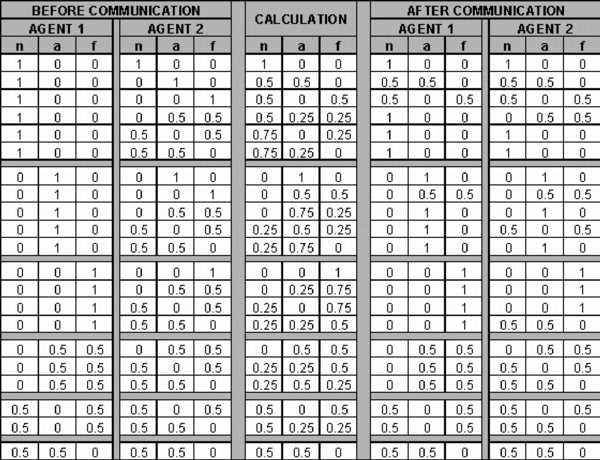
|
| Table 5. All possible communication situations between two agents and resulting agent types |

|
| Figure 3. Three examples of the potential outcomes of inter-agent communication. Top: a communication where both agents retain their initial socio-political types. Middle: a neo-liberal agent influences the second agent and, as a result, the second agent changes its type to neo-liberal. Bottom: both agents' types have changed as a consequence of inter-agent communication |

|
| Figure 4. Khepera robot/agent and sensors used in the simulation (lines represent the range of sensors that measure distance to objects) |
| Table 6: All possible agent behaviours in the simulation | ||
| Attitude | agent behaviour | description |
| -1 | turn | immediately turn around from issue |
| -0.5 | slow turn | turn around from issue |
| 0 | avoid | avoid issue |
| 0.5 | around | stay around issue |
| 1 | approach | approach issue |
| NO ISSUE DETECTED | random | random moving |

|
| Figure 5. Issue robot/agent and sensors used for an issue agent (lines represent sensors and their range) |
| Table 7: Strings emitted by an issue depending on its level of importance | ||
| issue | emitted string | |
| normal level of importance | high level of importance | |
| Market | 'mar' | 'MAR' |
| Individualism | 'ind' | 'IND' |
| Flexibility | 'flx' | 'FLX' |
| Tradition | 'tra' | 'TRA' |
| War | 'war' | 'WAR' |
| Religious tolerance | 'rel' | 'REL' |
| Materialism | 'mat' | 'MAT' |
| Redistribution of wealth | 'red' | 'RED' |

|
| Figure 6. Simulation world in the initial configuration. There are nine agents (shown in black) in the arena, and eight issues, each with a different colour. Agents and issues' are randomly distributed. The diagram in the middle shows agents' and issues sensor ranges and positions. The right diagram shows a 3D view of the world |

|
| Table 8. Number of all different simulation runs (400) carried out in this work |

|
| Table 9. All different experimental situations (80) studied in this work |

|
| Figure 7. Left: screenshot of the simulation at the start. Middle and right: screenshots at the end of two different simulation runs |
The sum of all agents' physical distances from their closest issue in the arena was measured for every simulation step. We calculated a value D as an indicator of the agents' spatial convergence towards the issues during the run. Its degree of fluctuation shows how smoothly the agents converge[7].

| D - Sum of all agents' distance from their closest issue. di - Distance of agent number 'i' from its closest issue. N - Number of agents (N=9). |
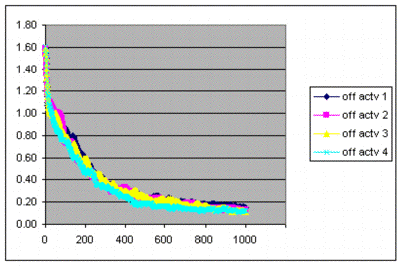 
|
| Figure 8. Convergence value D for two different agent positions with two different issue positions (communication off, active issues). Average value graph (left) and standard error graph (right) are shown |
 
|
| Figure 9. Convergence value D for two different agent positions with two different issue positions (communication on, active issues). Average value graph (left) and standard error graph (right) are shown |
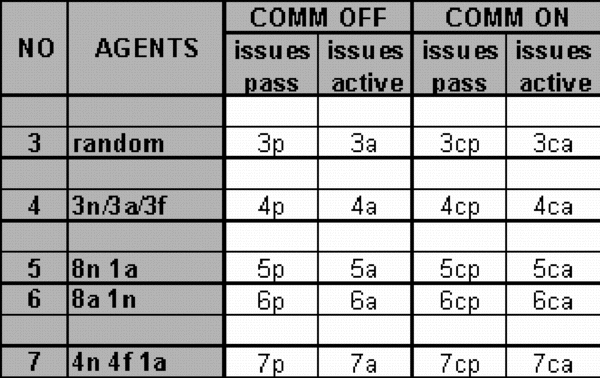
|
| Table 10. All different experimental situations studied here. For every different experimental situation (cell entry in the table), 20 independent simulations were run |
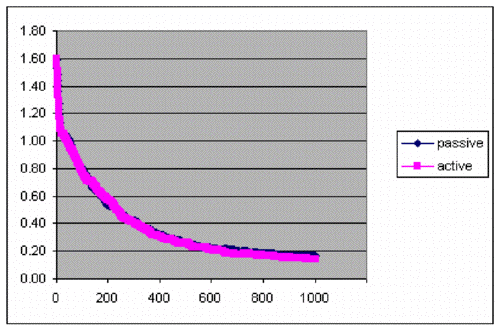 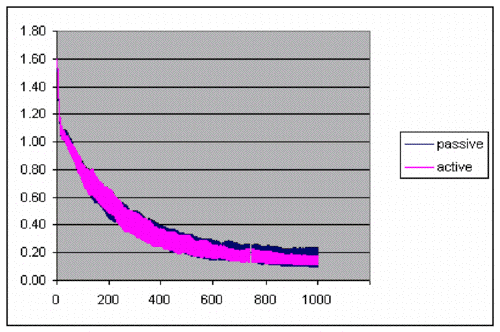
|
| Figure 10. Comparison of all situations with passive issues and active issues. Top: average convergence D graph, bottom: standard error of D graph |
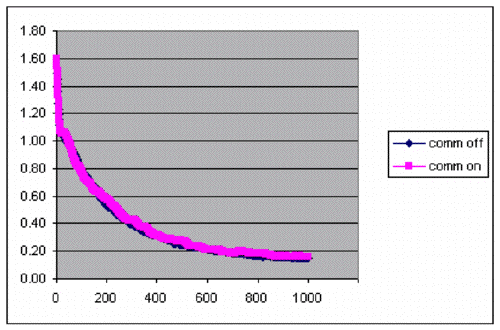 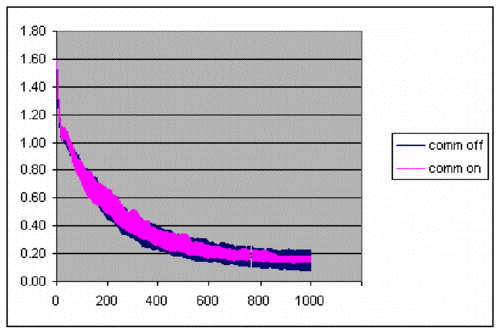
|
| Figure 11. Comparison of all situations with inter-agent communication off and on. Top: average convergence D graph, bottom: standard error of D graph |
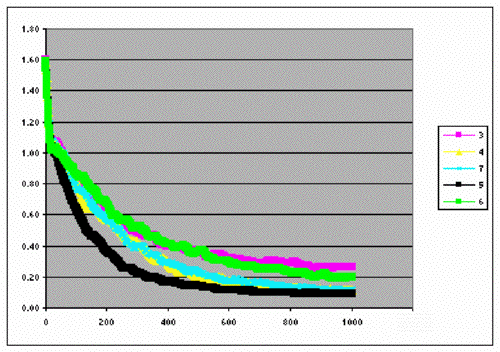 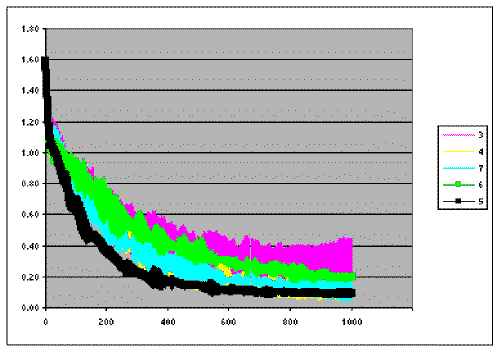
|
| Figure 12. Comparison of all experimental situations with different initial agents' types. Top: average convergence D graph, bottom: standard error of D graph |
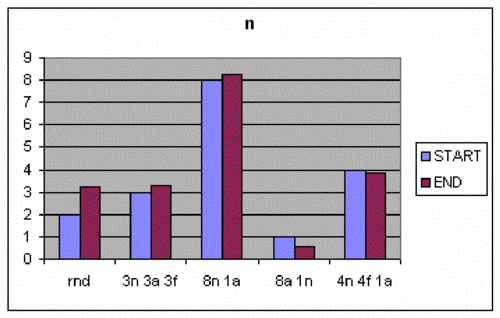 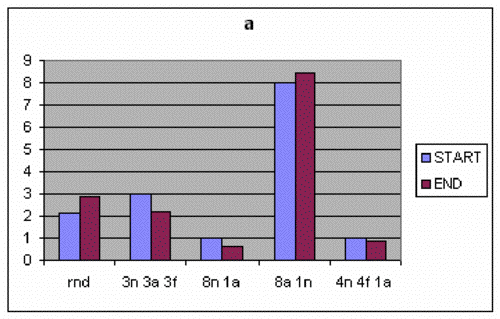 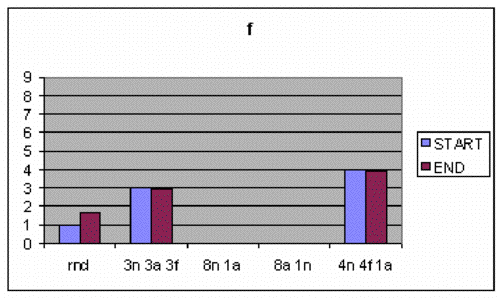
|
| Figure 13. Comparison of average number of neo-liberal (top), alternative (middle) and fundamentalist (bottom) agents at the start and at the end of the simulation for experimental situations with different initial agent types |
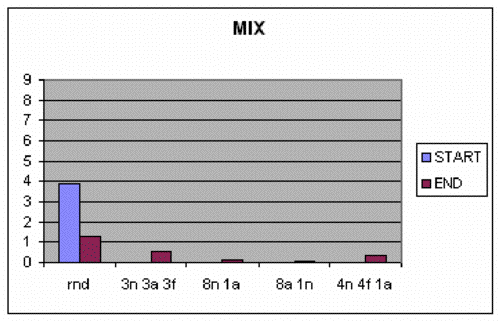
|
| Figure 14. Comparison of average number of agents with indeterminate socio-political types at the start and at the end of simulation for experimental situations with different initial agent types |
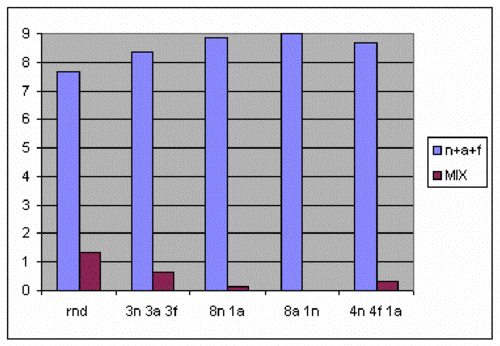
|
| Figure 15. Comparison of average number of agents with determinate (neo-liberal, alternative and fundamentalist) and indeterminate socio-political types at the end of simulation for experimental situations with different initial agent types |
2 For examples of Webots simulations please refer to the Webots web site at www.cyberbotics.com.
3 The Khepera robot is widely used in AI research community. It is small, practical and designed for research and education. The Webots simulation package is equipped with full support for Khepera robots. For more details, please refer to the Khepera web site at www.k-team.com.
4 During test simulation runs issues' and agents' emitter ranges were adjusted in order to obtain suitable physical proximity when an agent perceived an issue or another agent (i.e. when the agent's receiver receives an issue's or another agent's signal). Larger ranges result in agents that are communicating although they are physically remote, smaller ranges make the reception of signals unlikely.
5 Test runs have shown that the activation of three issue sensors occurs when two, three or four agents are present around the issue. The exact number depends on the agents' positions in relation to the issue's sensors, but in most cases it represents the presence of three agents.
6 When a scenario contains ten or more agents, the Webots simulation software runs very slowly.
7 During simulation all agents show a tendency to gather around issues towards which they have positive attitudes. In this way aggregations of agents positioned around issues are formed.
8 Standard error values for all data were also calculated.
9 For some references about communication theory models please refer to Hauser (1997), Smith (1977) and Pettersson (1993).
10 Except in the case of the random situation that contained the highest number of agents with indeterminate socio-political type, which shows the worst overall convergence toward issues.
AVILA-GARCÍA O and Cañamero L (2002), "A Comparison of Behavior Selection Architectures Using Viability Indicators". In Proc. International Workshop of Biologically-Inspired Robotics: The Legacy of W. Grey Walter, Bristol, UK.
BALZER W (1997), "Multi-agent systems for social simulation and BDI-architecture: A critical discussion". <http://www.uni-koblenz.de/kgt/dag9719/balzer.html>.
BRAITENBERG V (1984), Vehicles: Experiments in Synthetics Psychology. Cambridge, Massachusetts, MIT Press.
CASTELFRANCHI C, de Rosis F, Falcone R (1997), "Social Attitudes and Personalities in Agents, Socially Intelligent Agents". In AAAI Fall Symposium Series 1997, Cambridge, Massachusetts, MIT Press.
DAUTENHAHN K and Coles S J (2001), "Narrative Intelligence from the Bottom Up: A Computational Framework for the Study of Story-Telling in Autonomous Agents". In Journal of Artificial Societies and Social Simulation, vol. 4, no. 1, <http://www.soc.surrey.ac.uk/jasss/4/1/1.html>.
DAUTENHAHN K, Bond A H, Cañamero L and Edmonds B (2002), "Socially intelligent agents: creating relationships with computers and robots". In Dautenhahn K, Bond A H, Cañamero L and Edmonds, B (Eds.), Socially intelligent agents: creating relationships with computers and robots, Norwell, Mass., Kluwer Academic, pp. 1-20.
GUYE-VUILLÈME A and Thalmann D (2001), "A High-Level Architecture for Believable Social Agents". In VR Journal, 5, pp. 95-106.
HAUSER M D (1997), The Evolution of Communication. Cambridge, Massachusetts, MIT Press.
HUHNS M N and Stephens L M (1999), "Multiagent Systems and Societies of Agents". In Weiss G (Ed.), Multiagent systems: a modern approach to distributed artificial intelligence, Cambridge, Massachusetts, London, MIT Press, pp. 79-120.
IJSPEERT A J, Martinoli A, Billard A and Gambardella L M (2001), "Collaboration through the exploitation of local interactions in autonomous collective robotics: the stick pulling experiment". In Autonomous Robots, Vol. 11:2, pp. 149-171.
JAMESON F (1984), "Foreword". In Lyotard J F, The Postmodern Condition: A Report on Knowledge. Minneapolis and London, University of Minnesota Press.
KALENKA S and Jennings N R (1995), "On Social Attitudes: A Preliminary Report". In Proc. First Int. Workshop on Decentralised Intelligent Multi-Agent Systems, Krakov, Poland, pp. 233-240.
LIKERT R (1932), "A technique for the measurement of attitudes". In Archives of Psychology, 140, Columbia University Press, pp. 44-53.
LYOTARD J F (1979), La condition postmoderne. Paris, Minuit.
LYOTARD J F (1984), The Postmodern Condition: A Report on Knowledge. Minneapolis and London, University of Minnesota Press.
NEWTON A L (2002), "The Robot in Swarm, An Investigation into Agent Embodiment Within Virtualised Robotic Swarms". MSc thesis, Hatfield, UK, Faculty of Engineering and Information Science, University of Hertfordshire.
PETRIC M (2001), "Missing Narratives: The Notion of 'Grand Récit' in Artificial Agent Modelling". Paper delivered at Society of Literature and Science Annual Conference, Buffalo, N.Y.
PETRIC M, Tomic-Koludrovic I and Mitrovic I (2002), "Metanarratives and Believable Behavior: Developing Social Attitude Engines of Socially Intelligent Agents". In Lindemann G, Moldt D, Paolucci M and Yu B (Eds.), International Workshop on Regulated Agent-Based Social Systems: Theories and Applications (RASTA'02), Hamburg, Bibliothek Des Fachbereichs Informatik, Universitat Hamburg, pp. 61-70.
PETTERSSON R (1993), Visual Information. Englewood Cliffs NJ, Educational Technology Publications.
REILLY W S and Bates J (1992), "Building Emotional Agents". Technical Report CMU-CS-92-143, School of Computer Science, Carnegie Mellon University, Pittsburgh, PA.
ROUCHIER J (2002), "Social Intelligence for Computers, Making Artificial Entities Creative in their Interactions". In Dautenhahn K, Bond A H, Cañamero L and Edmonds B (Eds.), Socially intelligent agents: creating relationships with computers and robots, Norwell, Mass., Kluwer Academic, pp. 85-92.
ROUSSEAU D and Hayes-Roth B (1998), "A Social-Psychological Model for Synthetic Actors". In Proceedings 2nd International Conference on Autonomous Agents, Minneapolis, MN.
SENGERS P (2000), "Narrative Intelligence". In Dautenhahn K (Ed.), Human Cognition and Social Agent Technology, Advances in Consciousness Series, Philadelphia, PA, John Benjamins Publishing Company, pp.1-26.
SMITH W J (1977), The behavior of communication. Cambridge, MA, Harvard UP.
SNEDECOR G W and Cochran W G (1980), Statistical Methods. Ames, Iowa, Iowa State University Press.
STOCKER R, Cornforth D and Bossomaier T R J (2002), "Network Structures and Agreement in Social Network Simulations". In Journal of Artificial Societies and Social Simulation, vol. 5, no. 4, <https://www.jasss.org/5/4/3.html>.
SULEIMAN R and Fischer I (2000), "When One Decides for Many: The Effect of Delegation Methods on Cooperation in Simulated Inter-group Conflicts". In Journal of Artificial Societies and Social Simulation, vol. 3, no. 4, <http://www.soc.surrey.ac.uk/jasss/3/4/1.html>.
WEISS G (1999), "Prologue". In Weiss G (Ed.), Multiagent systems: a modern approach to distributed artificial intelligence. Cambridge, Massachusetts, London, MIT Press, pp. 1-23.
WOOLDRIDGE M (1999), "Intelligent Agents". In Weiss G (Ed.), Multiagent systems: a modern approach to distributed artificial intelligence. Cambridge, Massachusetts, London, MIT Press, pp. 28-77.
Return to Contents of this issue
© Copyright Journal of Artificial Societies and Social Simulation, [2003]